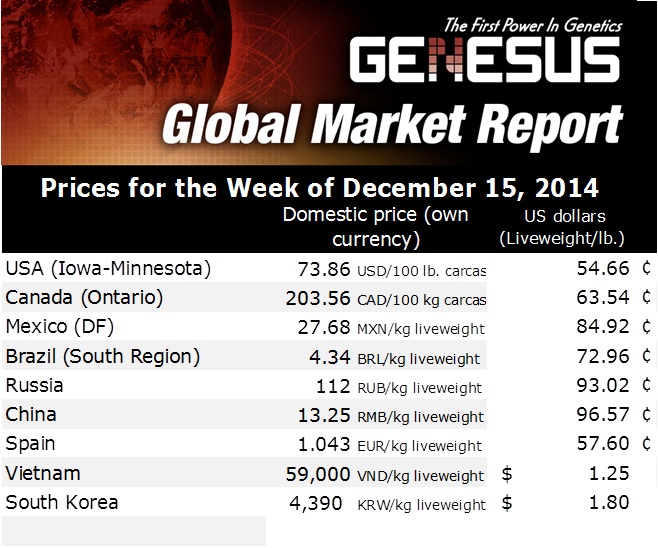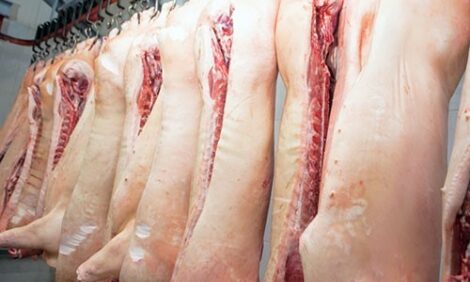



China: Hog Markets
CHINA - China, the pork powerhouse of the world, has over 51 per cent of the world’s population of pigs raised within China, writes Ron Lane, Senior Consultant for Genesus China.Looking at the size of the breakdown of the inventory for October 2014, the information from China Ministry of Agriculture (MOA) is indicating 435.63 million on-farm inventory and a 44.23 million sow herd (September 2014, there was 436.50 million on farm inventory and a 44.81 million sow herd).
The 435.63 million on farm inventory is down 0.2 per cent from last month and down 6.5 per cent from October 2013. The sow herd is down 1.30 per cent from last month and is down 11.3 per cent from one year ago.
Looking at the recently released figures for November 2014, the information from MOA is indicating 431.71 million on-farm inventory and a 43.70 million sow herd. The 431.71 million on-farm inventory is down 0.9 per cent from last month and down 7.4 per cent from November 2013.
The sow herd is down 1.2 per cent from last month and is down 12.1 per cent from one year ago. Again in November, another 531,000 sows were culled and/or eliminated from the total national herd.
Along with the 583,000 sows for October, 225,000 in September, 360,000 in August, 550,000 in July, 464,000 in June, 470,000 in May and 1.05 million from April, the past eight months has seen more than 4.33 million sows eliminated.
The current sow inventory is the lowest level in four years. It is expected that there will be more sows lost in the next few months as rumours of Foot and Mouth Disease in Henan and Guangxi may make farmers sell off inventory. The 12.1 per cent loss in sow numbers is approaching, if not more than the total number of sows in the USA - number two in the world for sow numbers.
Hog production capacity has significantly been adjusted with the main cause being the loss of farm households. Recent recovery of the market price for live pigs has gone and prices are again lower than before — but feed costs are declining.
Several farm households are deep in financial difficulty and rumours of bankruptcy of large farms are being touted by the industry. Factors such as disease, cold weather and/or home consumption (mainly backyard farms) for Holidays, have all affected the total on farm inventory.
Recently, the low prices have been sending sows to market as small farmers are lowering the sow herd size or are totally quitting the business. With the huge drop in sow inventory and with fewer market pigs coming to market, will the market price soon show a rapid rebound or will imports, especially from the US marketplace ( mainly by the WH Group) ramp-up for delivery into China.
Piglet prices continue to fall. The national average piglet price for 10 December was RMB20.42 per kg (US$3.34 per kg; US$1.51 per lb.). This is down by 1.2 per cent from one week before (3 December 2014) and from one year before by 20.8 per cent .
Pork prices continue to fall - the first week of December with prices at RMB19.7 per kg (US$3.22 per kg; US$1.46 per lb.). The fall making of bacon has been slow to start this year and this keeps the price of pork lower than expected for this time of the year.
Also, the warm weather is keeping pork consumption lower than usual. With winter coming, the farmers will see more fluctuation in daytime/nighttime temperatures which can lead to more swine flu and piglet diarrhoea and slower growth.
Pig to grain ratio last Friday was 5.67:1 which is still below the traditional break-even point of 6.00:1 and roughly the same as six weeks ago. The market pig price from last winter to now has mainly shown a loss to producers.
From January to September, the national average price of a live market pig has been about RMB13.24 per kg (US$2.16 per kg; US$0.98 per lb.). This price is 10.64 per cent lower than the same time-frame last year. Prices for October and November continued to fall.
The average loss of profit during 2014 was estimated at RMB200 per market pig (US$32.68 per market pig). A new benchmark for cost of production in China is about RMB1,300 per pig (US$212.66 per pig).
The Consumer Price Index (CPI) continues to be quite interesting for the national government. The CPI is made up of about 31.8 per cent food found in the consumers’ basket. Pork is estimated to be about one-third of the food portion of the basket or in other words, about 10 per cent of CPI as a whole. CPI was 101.60 index points for November - the year-on-year lowest reading since January 2010, down from October (101.70 points) and down from September (101.80).
Currently, the pork prices are keeping the CPI lower but a substantial increase, likely towards the end of this year, will cause national government concern. As a measure, when pig prices increase, CPI should increase. National inflation target for 2014 is 3.5 per cent.
Many Chinese companies are looking towards Russia to export meat products. Recently, Russia has allowed China (not since 2004 has any exports been allowed) to commence the trade of mainly pork.
China wants to approve 10 companies for exporting pork to Russia. To date, only two companies - WH Group (Shuanghui) and Beidahuang are approved. Both companies are sourcing product from plants located in the northeast of China.
Currently, WH Group has exported about 3,000 tonnes of frozen meat from Heilongjiang slaughter plants. Five other companies have applied to AQSIQ for approval including: China Yurun Group (Jiangsu); Sichuan Gaijin Food Co. (Sichuan); Shunxin Agriculture C. (Beijing); Linyi Xincheng JinLuo Meat Products Group (Hunan) and Delisi (Shandong).
The Shuanghui Group continues to strengthen its position in China by inking a partnership with both Metro Group (German wholesale and retail chain) and Da Chong Hong (DCH) Holdings to strengthen its cold chain logistics. Metro Group has 79 warehouse-style wholesale stores located throughout China.
DCH has strong position in Southern China. Both stores with distribute Shuanghui products.
China has imported 72.49 million metric tonnes of cereals including soybeans, rice, corn and wheat for the first 10 months of 2014. This is an increase of 19 per cent from the same period as last year.
As a major importer, China has a huge influence on global prices. However, this year, the main factor in buying offshore relates to the cheaper international prices versus the domestic market prices. Due to general farming conditions and high input costs, China purchased 56.84 million tonnes of soybeans during the first 10 months of 2014.
China’s grain production rose by 0.9 per cent (year on year) to 607.1 million tonnes for 2014. The national government will not allow the commercial production of GMO grains. China will employ measures to import non-staple grain and related products, such as soybeans, feed and processed grains and will concentrate on the production of food staples for food security.










